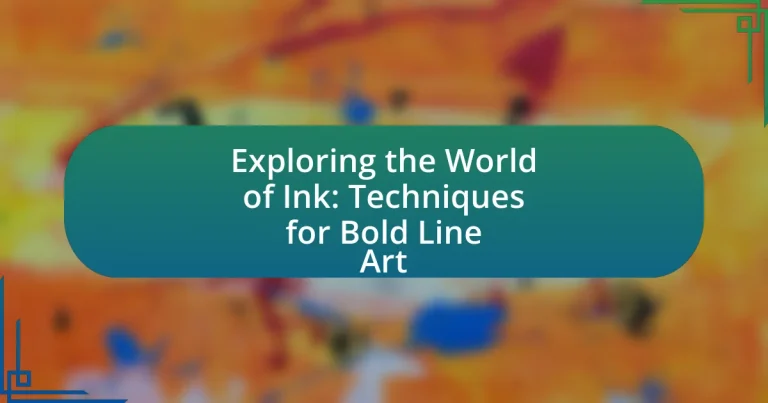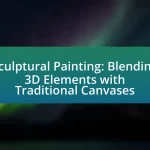The article “Exploring the World of Ink: Techniques for Bold Line Art” delves into the essential elements of bold line art created with ink, emphasizing the significance of line thickness, ink choice, and the tools used. It discusses how different inks and their viscosities affect line quality, while also highlighting the importance of composition and varying line weights in enhancing visual interest. Additionally, the article provides practical advice on overcoming common challenges in bold line art, such as achieving consistent line weight and preventing bleeding, along with effective practice methods for skill development. Overall, it serves as a comprehensive guide for artists looking to master bold line techniques in their work.
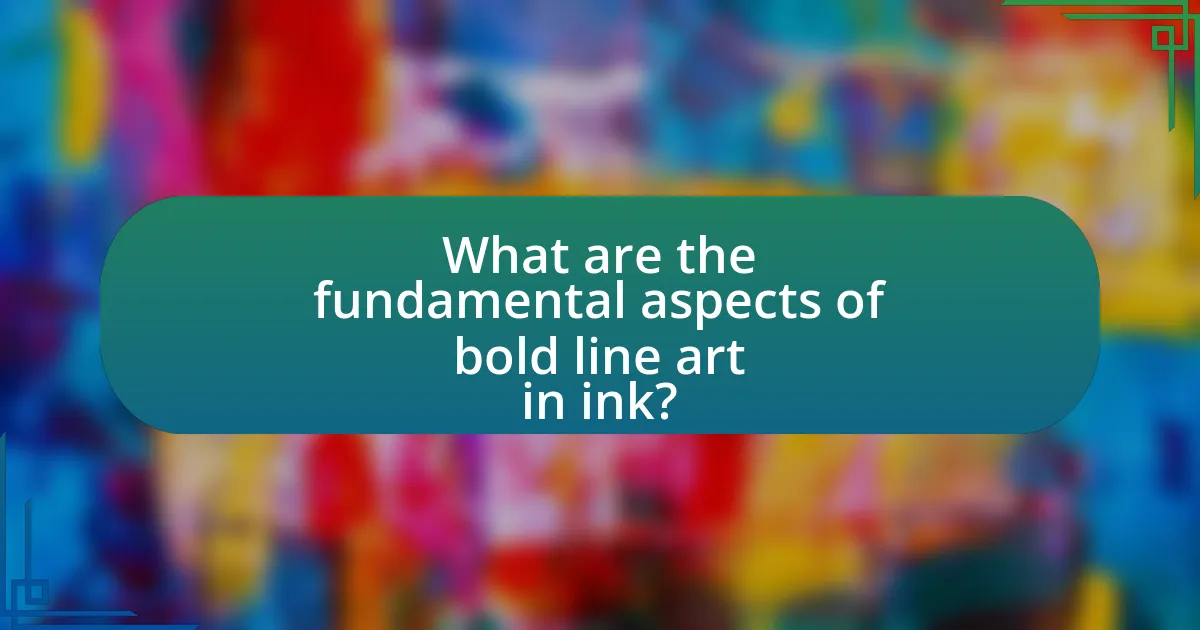
What are the fundamental aspects of bold line art in ink?
Bold line art in ink is characterized by its use of thick, defined lines that create strong visual impact and clarity. This technique emphasizes contrast and can convey depth and texture through varying line weights. The application of bold lines often enhances the overall composition, making elements stand out and guiding the viewer’s eye. Historically, artists like Hokusai and contemporary illustrators have utilized bold line art to achieve striking imagery, demonstrating its effectiveness in both traditional and modern contexts.
How does ink choice influence the quality of line art?
Ink choice significantly influences the quality of line art by affecting the clarity, consistency, and permanence of the lines. Different inks, such as India ink, acrylic ink, or gel ink, offer varying levels of opacity, flow, and drying time, which directly impact the final appearance of the artwork. For instance, India ink is known for its deep black color and smooth application, resulting in crisp, clean lines that enhance detail in line art. In contrast, water-based inks may produce softer lines and can bleed on certain papers, compromising the precision of the artwork. Additionally, the viscosity of the ink affects how it interacts with different tools, such as brushes or pens, influencing the overall texture and style of the line work. Therefore, selecting the appropriate ink is crucial for achieving the desired quality and aesthetic in line art.
What types of ink are best for bold line art?
Pigment-based inks are best for bold line art due to their high opacity and vibrant colors. These inks provide strong, consistent lines that stand out on various surfaces. Additionally, India ink, a type of pigment-based ink, is particularly favored for its deep black color and permanence, making it ideal for bold outlines. Water-resistant and quick-drying properties of these inks further enhance their suitability for bold line art, ensuring that the lines remain sharp and defined over time.
How does ink viscosity affect line thickness?
Ink viscosity directly influences line thickness; higher viscosity results in thicker lines, while lower viscosity produces thinner lines. This is due to the resistance of the ink to flow; more viscous inks resist movement, leading to a greater accumulation of ink on the surface, thus creating thicker lines. Conversely, less viscous inks flow more easily, allowing for finer lines. Studies in fluid dynamics confirm that viscosity affects the flow rate and behavior of liquids, which directly correlates to the thickness of the lines produced in art and printing applications.
What tools are essential for creating bold line art?
Essential tools for creating bold line art include high-quality ink pens, brushes, and paper. Ink pens, such as fineliners or brush pens, provide precision and control, allowing artists to create thick, bold lines. Brushes, particularly those with flexible bristles, enable varied line thickness and expressive strokes. Additionally, smooth, heavyweight paper is crucial as it supports ink application without bleeding, ensuring clean, sharp lines. These tools collectively enhance the artist’s ability to produce striking and impactful line art.
What types of pens and brushes are commonly used?
Commonly used types of pens include fountain pens, gel pens, and fineliners, while popular brushes consist of round brushes, flat brushes, and watercolor brushes. Fountain pens are favored for their smooth ink flow and versatility, gel pens are known for their vibrant colors and quick-drying properties, and fineliners are preferred for precise line work. Round brushes are ideal for detail and versatility in painting, flat brushes are used for broad strokes and filling in areas, and watercolor brushes are designed for fluid application of water-based paints. These tools are essential in creating bold line art, as they offer various line qualities and effects that enhance artistic expression.
How do different tools impact the final artwork?
Different tools significantly impact the final artwork by influencing the texture, precision, and overall aesthetic of the piece. For instance, using a fine-tipped pen allows for intricate details and sharp lines, while a brush can create softer, more fluid strokes. The choice of tool directly affects the visual outcome; for example, a dip pen produces varying line widths based on pressure, which can enhance the dynamic quality of bold line art. Additionally, tools like markers or digital styluses offer different levels of control and versatility, allowing artists to experiment with styles and techniques. Historical evidence shows that artists like Hokusai utilized specific brushes to achieve unique effects in their ink work, demonstrating how tool selection can shape artistic expression.
What techniques can artists use to achieve bold lines?
Artists can achieve bold lines through techniques such as using a brush with a thick bristle, employing a wide-tipped pen, or utilizing markers designed for bold strokes. These tools allow for greater ink flow and pressure, resulting in more pronounced lines. For instance, using a brush with a thick bristle can create dynamic, expressive lines due to the varying pressure applied during strokes. Similarly, wide-tipped pens and bold markers are specifically designed to deliver a consistent, thick line, making them ideal for artists aiming for boldness in their work.
How does pressure application affect line boldness?
Pressure application directly influences line boldness by altering the thickness of the ink flow. When greater pressure is applied to a drawing tool, such as a pen or brush, the ink is dispensed more liberally, resulting in thicker, bolder lines. Conversely, lighter pressure leads to finer lines due to reduced ink flow. This relationship is supported by the mechanics of ink delivery systems, where pressure variations directly correlate with the volume of ink released, thus affecting the visual weight of the lines produced.
What are the benefits of varying line weight in art?
Varying line weight in art enhances visual interest and depth, allowing artists to create emphasis and guide the viewer’s eye. This technique helps differentiate between foreground and background elements, making compositions more dynamic. For instance, thicker lines can denote strength or importance, while thinner lines can suggest delicacy or detail. Additionally, varying line weight can evoke emotional responses; bold lines may convey power, while softer lines can imply gentleness. Historical examples include the works of artists like Albrecht Dürer, who utilized line weight to create texture and dimension in his engravings, demonstrating its effectiveness in enhancing artistic expression.
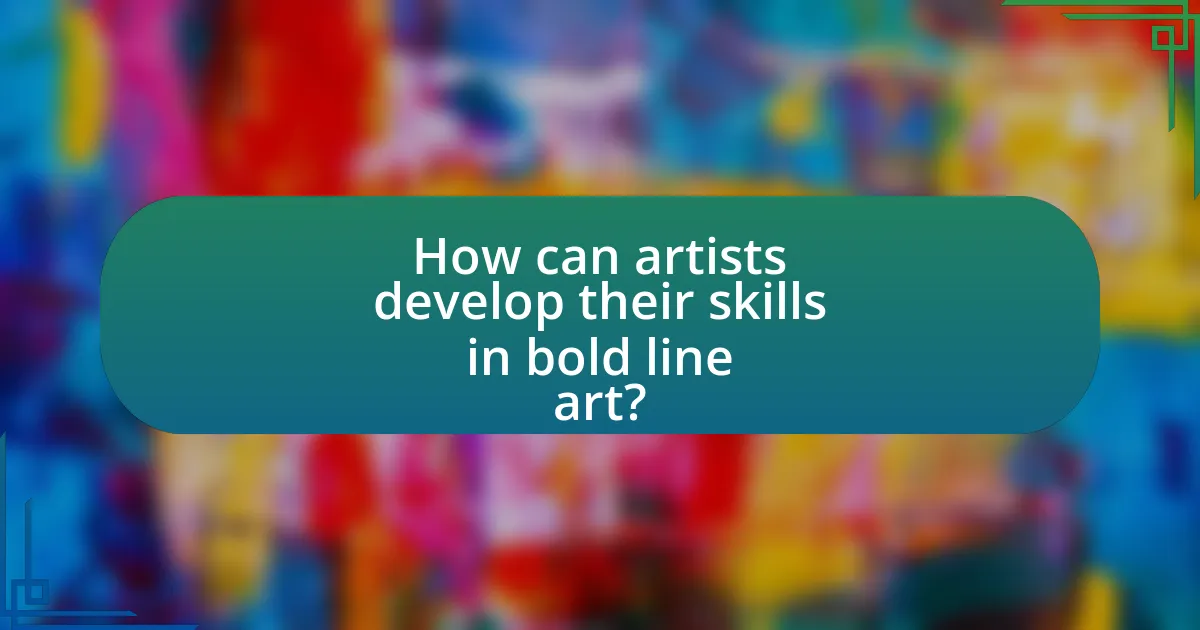
How can artists develop their skills in bold line art?
Artists can develop their skills in bold line art by practicing consistent line quality and experimenting with various tools. Regularly drawing with pens or brushes that create bold lines helps artists understand pressure control and stroke variation. Engaging in exercises such as contour drawing and studying the works of established bold line artists can enhance their technique. Additionally, analyzing the use of negative space and composition in bold line art can provide insights into effective design choices. Research indicates that deliberate practice and feedback from peers significantly improve artistic skills, as noted in studies on skill acquisition in visual arts.
What practice methods are effective for mastering bold line techniques?
Effective practice methods for mastering bold line techniques include consistent line drills, studying the work of established artists, and utilizing varied tools. Consistent line drills, such as drawing straight lines, curves, and shapes repeatedly, help develop muscle memory and control. Studying the work of established artists allows practitioners to analyze how bold lines are used for emphasis and composition. Utilizing varied tools, such as different pen sizes and types, enables artists to explore the effects of line weight and texture, enhancing their understanding of bold line application. These methods are supported by the fact that artists who engage in regular practice and analysis show marked improvement in their line work skills.
How can artists use exercises to improve their line control?
Artists can improve their line control by practicing specific exercises that focus on precision and consistency. These exercises include drawing straight lines, curves, and varying line weights repeatedly to develop muscle memory and hand-eye coordination. For instance, drawing parallel lines at different angles helps artists understand pressure application and control, which is essential for creating bold line art. Research indicates that repetitive practice enhances fine motor skills, which directly correlates with improved line control in artistic endeavors.
What role does observation play in skill development?
Observation is crucial in skill development as it allows individuals to analyze techniques, understand nuances, and replicate successful practices. By closely observing skilled practitioners, learners can identify effective methods and strategies that contribute to mastery. Research indicates that observational learning, as described by Albert Bandura, enhances skill acquisition by enabling individuals to model behaviors and refine their own techniques based on what they see. This process is particularly relevant in artistic fields, such as bold line art, where visual cues and stylistic elements are essential for creating impactful work.
Why is understanding composition important in bold line art?
Understanding composition is crucial in bold line art because it determines how elements are arranged to create visual balance and focus. Effective composition guides the viewer’s eye, enhances the narrative, and emphasizes key features within the artwork. For instance, the rule of thirds can be applied to position focal points strategically, making the artwork more engaging. Additionally, a well-composed piece can evoke specific emotions and reactions, as seen in the works of artists like Hokusai, who utilized composition to draw attention to the dynamic interplay between subjects and backgrounds. Thus, mastery of composition directly influences the impact and clarity of bold line art.
How does composition influence the perception of bold lines?
Composition significantly influences the perception of bold lines by determining their visual impact and contextual relevance within an artwork. The arrangement of elements, such as balance, contrast, and focal points, can enhance or diminish the prominence of bold lines. For instance, a bold line placed against a contrasting background will draw more attention than one set against a similar tone. Additionally, the use of negative space around bold lines can create a sense of movement or tension, further affecting how they are perceived. Research in visual perception indicates that viewers are more likely to notice and interpret bold lines as significant when they are strategically positioned within a well-structured composition, as evidenced by studies on visual hierarchy and attention in art.
What are common compositional mistakes to avoid?
Common compositional mistakes to avoid include poor balance, lack of focal points, and ineffective use of negative space. Poor balance occurs when elements are unevenly distributed, leading to a visually unappealing composition. A lack of focal points can confuse viewers, as they may not know where to direct their attention. Ineffective use of negative space can result in cluttered designs that detract from the main subject. These mistakes can undermine the overall impact of bold line art, making it essential for artists to be mindful of these aspects to create compelling compositions.
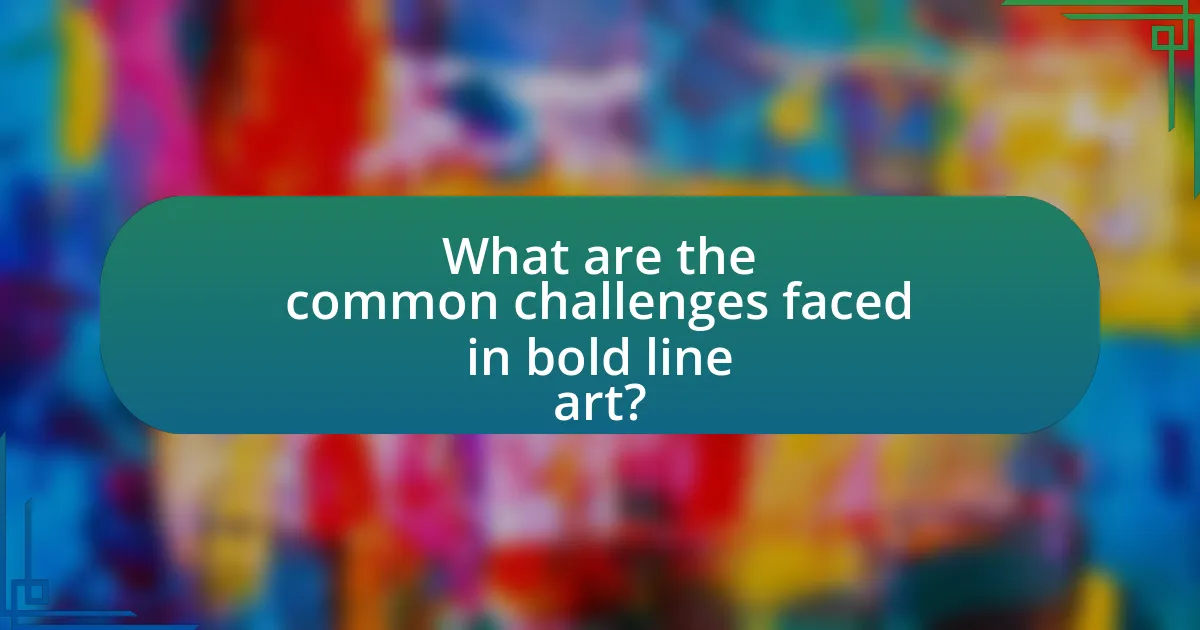
What are the common challenges faced in bold line art?
Common challenges faced in bold line art include achieving consistent line weight, maintaining clarity in complex designs, and ensuring smooth, clean lines. Artists often struggle with line weight consistency due to variations in pressure and speed during application, which can lead to an uneven appearance. Clarity in complex designs is another challenge, as intricate details can become muddled when using bold lines, making it difficult for viewers to discern the intended shapes and forms. Additionally, achieving smooth, clean lines requires a high level of control and precision, which can be difficult to master, especially for beginners. These challenges are well-documented in art education literature, emphasizing the importance of practice and technique in overcoming them.
What issues do artists encounter with ink application?
Artists encounter several issues with ink application, including inconsistent flow, bleeding, and drying times. Inconsistent flow can result from clogged nibs or poor-quality ink, leading to uneven lines. Bleeding occurs when ink spreads beyond the intended area, often due to paper absorbency or ink viscosity, which can compromise the artwork’s precision. Additionally, drying times can vary significantly between different inks, affecting layering techniques and the overall finish of the piece. These challenges necessitate careful selection of materials and techniques to achieve desired outcomes in bold line art.
How can bleeding and smudging be prevented?
Bleeding and smudging can be prevented by using high-quality, bleed-resistant paper and appropriate ink types. High-quality paper is designed to absorb ink without allowing it to spread beyond the intended lines, while specific inks, such as pigment-based inks, are less prone to bleeding compared to dye-based inks. Additionally, allowing sufficient drying time between layers of ink can further minimize the risk of smudging. Studies have shown that using paper with a higher weight and texture can significantly reduce bleeding, ensuring cleaner and sharper lines in bold line art.
What techniques help in achieving clean lines?
Techniques that help in achieving clean lines include using high-quality tools, maintaining consistent pressure, and practicing steady hand movements. High-quality tools, such as fine-tipped pens or brushes, allow for precision and control, which are essential for clean lines. Maintaining consistent pressure while drawing ensures uniformity in line thickness, preventing variations that can lead to a messy appearance. Additionally, practicing steady hand movements helps in reducing wobbles and irregularities, resulting in smoother lines. These techniques are widely recognized in the field of ink art, where clarity and precision are paramount for bold line work.
How can artists overcome creative blocks in line art?
Artists can overcome creative blocks in line art by implementing structured techniques such as setting specific goals, experimenting with different styles, and taking breaks to refresh their perspective. Setting clear, achievable goals helps artists focus their efforts and provides a sense of direction, which can alleviate feelings of being overwhelmed. Experimenting with various styles or mediums can stimulate creativity by introducing new ideas and approaches, allowing artists to break free from their usual patterns. Additionally, taking breaks has been shown to enhance creativity; research indicates that stepping away from a task can lead to improved problem-solving and idea generation upon return.
What strategies can be employed to find inspiration?
To find inspiration for bold line art, artists can employ strategies such as exploring nature, studying the works of other artists, and engaging in creative exercises. Exploring nature allows artists to observe shapes, patterns, and colors that can influence their line work. Studying the works of renowned artists, such as those from the ink drawing tradition, can provide insights into techniques and styles that resonate with the artist’s vision. Engaging in creative exercises, like doodling or setting time limits for quick sketches, can stimulate spontaneous ideas and help overcome creative blocks. These strategies are effective as they encourage observation, learning, and experimentation, which are essential components of the artistic process.
How does experimentation contribute to overcoming blocks?
Experimentation contributes to overcoming blocks by allowing artists to explore new techniques and materials, which can lead to unexpected breakthroughs in creativity. Engaging in experimentation encourages a mindset of flexibility and openness, enabling artists to step outside their comfort zones and discover innovative solutions to artistic challenges. For instance, artists who try different ink types or application methods may find unique textures or effects that inspire new ideas, thus alleviating creative stagnation. This process is supported by studies indicating that creative problem-solving often improves when individuals engage in trial-and-error approaches, as it fosters resilience and adaptability in the face of obstacles.
What are some best practices for creating bold line art?
To create bold line art, use consistent line weight and high-contrast colors. Consistent line weight ensures that the artwork maintains visual coherence, while high-contrast colors enhance the boldness of the lines against the background. Additionally, employing a limited color palette can help emphasize the lines and shapes, making the artwork more striking. Techniques such as varying line thickness can also add depth and interest, as seen in the works of artists like Hokusai, who effectively used line variation to create dynamic compositions.
How can artists maintain consistency in their line work?
Artists can maintain consistency in their line work by developing a steady hand through practice and using tools that provide uniformity, such as specific pens or brushes. Regular practice helps artists build muscle memory, which leads to more controlled and consistent strokes. Additionally, selecting tools with similar nib sizes and ink flow can ensure that the line quality remains uniform across different pieces. Studies in art education emphasize the importance of repetitive practice in achieving technical proficiency, which directly correlates with consistent line work.
What tips can enhance the overall impact of bold line art?
To enhance the overall impact of bold line art, artists should focus on contrast, composition, and line quality. High contrast between the lines and the background can make the artwork more striking, as seen in the works of artists like Keith Haring, who utilized bold lines against vibrant colors to create visual tension. Effective composition, including the use of negative space, directs the viewer’s eye and emphasizes the bold lines, as demonstrated in the minimalist approach of artists like Piet Mondrian. Additionally, varying line quality—such as thickness and texture—adds depth and interest, which is evident in the intricate line work of artists like Albrecht Dürer. These techniques collectively contribute to a more engaging and impactful presentation of bold line art.
